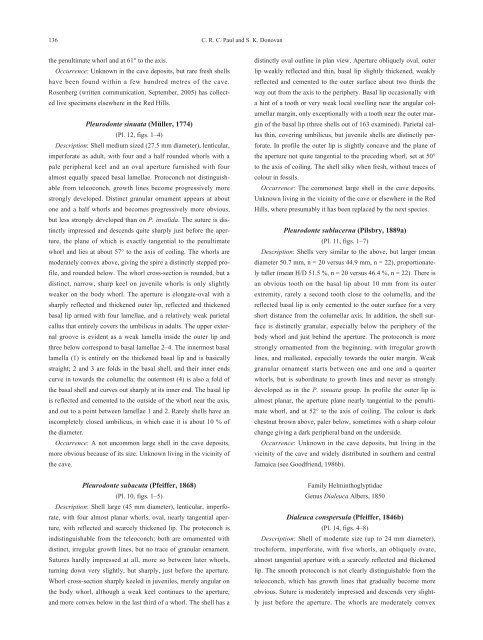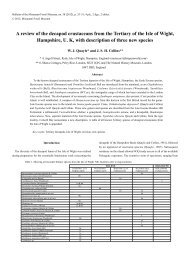Quaternary and Recent land snails (Mollusca: Gastropoda) from ...
Quaternary and Recent land snails (Mollusca: Gastropoda) from ...
Quaternary and Recent land snails (Mollusca: Gastropoda) from ...
Create successful ePaper yourself
Turn your PDF publications into a flip-book with our unique Google optimized e-Paper software.
136<br />
the penultimate whorl <strong>and</strong> at 61° to the axis.<br />
Occurrence: Unknown in the cave deposits, but rare fresh shells<br />
have been found within a few hundred metres of the cave.<br />
Rosenberg (written communication, September, 2005) has collected<br />
live specimens elsewhere in the Red Hills.<br />
Pleurodonte sinuata (Müller, 1774)<br />
(Pl. 12, figs. 1–4)<br />
Description: Shell medium sized (27.5 mm diameter), lenticular,<br />
imperforate as adult, with four <strong>and</strong> a half rounded whorls with a<br />
pale peripheral keel <strong>and</strong> an oval aperture furnished with four<br />
almost equally spaced basal lamellae. Protoconch not distinguishable<br />
<strong>from</strong> teleoconch, growth lines become progressively more<br />
strongly developed. Distinct granular ornament appears at about<br />
one <strong>and</strong> a half whorls <strong>and</strong> becomes progressively more obvious,<br />
but less strongly developed than on P. invalida. The suture is distinctly<br />
impressed <strong>and</strong> descends quite sharply just before the aperture,<br />
the plane of which is exactly tangential to the penultimate<br />
whorl <strong>and</strong> lies at about 57° to the axis of coiling. The whorls are<br />
moderately convex above, giving the spire a distinctly stepped profile,<br />
<strong>and</strong> rounded below. The whorl cross-section is rounded, but a<br />
distinct, narrow, sharp keel on juvenile whorls is only slightly<br />
weaker on the body whorl. The aperture is elongate-oval with a<br />
sharply reflected <strong>and</strong> thickened outer lip, reflected <strong>and</strong> thickened<br />
basal lip armed with four lamellae, <strong>and</strong> a relatively weak parietal<br />
callus that entirely covers the umbilicus in adults. The upper external<br />
groove is evident as a weak lamella inside the outer lip <strong>and</strong><br />
three below correspond to basal lamellae 2–4. The innermost basal<br />
lamella (1) is entirely on the thickened basal lip <strong>and</strong> is basically<br />
straight; 2 <strong>and</strong> 3 are folds in the basal shell, <strong>and</strong> their inner ends<br />
curve in towards the columella; the outermost (4) is also a fold of<br />
the basal shell <strong>and</strong> curves out sharply at its inner end. The basal lip<br />
is reflected <strong>and</strong> cemented to the outside of the whorl near the axis,<br />
<strong>and</strong> out to a point between lamellae 1 <strong>and</strong> 2. Rarely shells have an<br />
incompletely closed umbilicus, in which case it is about 10 % of<br />
the diameter.<br />
Occurrence: A not uncommon large shell in the cave deposits,<br />
more obvious because of its size. Unknown living in the vicinity of<br />
the cave.<br />
Pleurodonte subacuta (Pfeiffer, 1868)<br />
(Pl. 10, figs. 1–5)<br />
Description: Shell large (45 mm diameter), lenticular, imperforate,<br />
with four almost planar whorls, oval, nearly tangential aperture,<br />
with reflected <strong>and</strong> scarcely thickened lip. The protoconch is<br />
indistinguishable <strong>from</strong> the teleoconch; both are ornamented with<br />
distinct, irregular growth lines, but no trace of granular ornament.<br />
Sutures hardly impressed at all, more so between later whorls,<br />
turning down very slightly, but sharply, just before the aperture.<br />
Whorl cross-section sharply keeled in juveniles, merely angular on<br />
the body whorl, although a weak keel continues to the aperture,<br />
<strong>and</strong> more convex below in the last third of a whorl. The shell has a<br />
C. R. C. Paul <strong>and</strong> S. K. Donovan<br />
distinctly oval outline in plan view. Aperture obliquely oval, outer<br />
lip weakly reflected <strong>and</strong> thin, basal lip slightly thickened, weakly<br />
reflected <strong>and</strong> cemented to the outer surface about two thirds the<br />
way out <strong>from</strong> the axis to the periphery. Basal lip occasionally with<br />
a hint of a tooth or very weak local swelling near the angular columellar<br />
margin, only exceptionally with a tooth near the outer margin<br />
of the basal lip (three shells out of 163 examined). Parietal callus<br />
thin, covering umbilicus, but juvenile shells are distinctly perforate.<br />
In profile the outer lip is slightly concave <strong>and</strong> the plane of<br />
the aperture not quite tangential to the preceding whorl, set at 50°<br />
to the axis of coiling. The shell silky when fresh, without traces of<br />
colour in fossils.<br />
Occurrence: The commonest large shell in the cave deposits.<br />
Unknown living in the vicinity of the cave or elsewhere in the Red<br />
Hills, where presumably it has been replaced by the next species.<br />
Pleurodonte sublucerna (Pilsbry, 1889a)<br />
(Pl. 11, figs. 1–7)<br />
Description: Shells very similar to the above, but larger (mean<br />
diameter 50.7 mm, n = 20 versus 44.9 mm, n = 22), proportionately<br />
taller (mean H/D 51.5 %, n = 20 versus 46.4 %, n = 22). There is<br />
an obvious tooth on the basal lip about 10 mm <strong>from</strong> its outer<br />
extremity, rarely a second tooth close to the columella, <strong>and</strong> the<br />
reflected basal lip is only cemented to the outer surface for a very<br />
short distance <strong>from</strong> the columellar axis. In addition, the shell surface<br />
is distinctly granular, especially below the periphery of the<br />
body whorl <strong>and</strong> just behind the aperture. The protoconch is more<br />
strongly ornamented <strong>from</strong> the beginning, with irregular growth<br />
lines, <strong>and</strong> malleated, especially towards the outer margin. Weak<br />
granular ornament starts between one <strong>and</strong> one <strong>and</strong> a quarter<br />
whorls, but is subordinate to growth lines <strong>and</strong> never as strongly<br />
developed as in the P. sinuata group. In profile the outer lip is<br />
almost planar, the aperture plane nearly tangential to the penultimate<br />
whorl, <strong>and</strong> at 52° to the axis of coiling. The colour is dark<br />
chestnut brown above, paler below, sometimes with a sharp colour<br />
change giving a dark peripheral b<strong>and</strong> on the underside.<br />
Occurrence: Unknown in the cave deposits, but living in the<br />
vicinity of the cave <strong>and</strong> widely distributed in southern <strong>and</strong> central<br />
Jamaica (see Goodfriend, 1986b).<br />
Family Helminthoglyptidae<br />
Genus Dialeuca Albers, 1850<br />
Dialeuca conspersula (Pfeiffer, 1846b)<br />
(Pl. 14, figs. 4–8)<br />
Description: Shell of moderate size (up to 24 mm diameter),<br />
trochiform, imperforate, with five whorls, an obliquely ovate,<br />
almost tangential aperture with a scarcely reflected <strong>and</strong> thickened<br />
lip. The smooth protoconch is not clearly distinguishable <strong>from</strong> the<br />
teleoconch, which has growth lines that gradually become more<br />
obvious. Suture is moderately impressed <strong>and</strong> descends very slightly<br />
just before the aperture. The whorls are moderately convex





